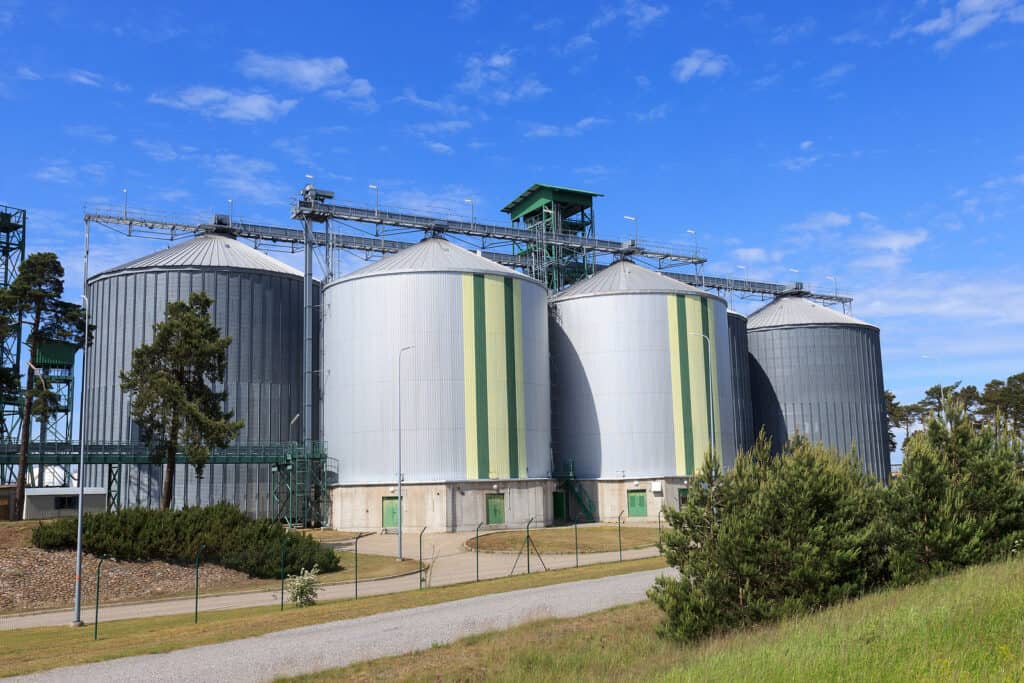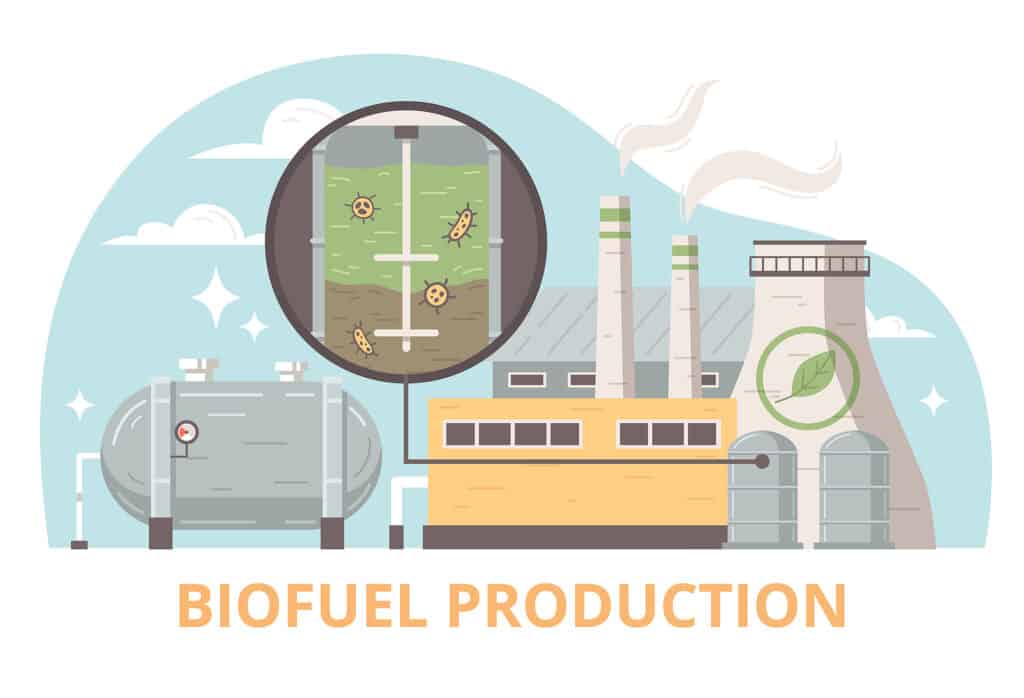From Plant to Pump: The Power of Biomass and Biofuels in a Greener World
In today's era of rapid climate change and mounting environmental concerns, our company recognizes the pressing need to find renewable and eco-friendly energy sources. We are committed to taking action and contributing to a sustainable future. That's why we have turned our attention to biomass and biofuels as a promising solution.
By harnessing the power of plants to generate energy, biomass and biofuels offer a viable alternative to fossil fuels. As a company that generates significant amounts of organic waste, such as food processing or brewing waste, we have realized the immense potential in utilizing anaerobic digestion and other bioenergy technologies. Through these innovative processes, we can convert our organic waste into valuable resources like biogas or biofuels.
What is Biomass Used For?
Biomass, as nature's energy store, encompasses a wide range of organic materials derived from living or recently living organisms. Primarily derived from plants or plant-based sources, biomass includes various materials such as agricultural residues, dedicated energy crops, forestry residues, algae, and even certain types of waste residues. Here's a detailed look at biomass and its subset, biofuels:
Biomass: Nature's Energy Store
- Agricultural Residues: These are byproducts or waste materials generated from agricultural activities, such as crop residues (stalks, husks, leaves), straw, and fruit peels. These residues can be converted into valuable energy sources.
- Dedicated Energy Crops: Specific crops, like switchgrass, miscanthus, or fast-growing trees, are cultivated specifically for their energy potential. These crops have high energy content and are grown in a sustainable manner to minimize environmental impacts.
- Forestry Residues: Derived from forestry operations, such as logging or timber processing, these residues include branches, bark, sawdust, and wood chips. These materials can be used as biomass feedstock for energy production.
- Algae: Certain species of algae have high oil content and can be cultivated to produce biofuels, including biodiesel. Algae can be grown in various environments, including ponds, tanks, or even photobioreactors.
- Waste Residues: Some types of waste, such as food waste, organic municipal waste, and sewage sludge, can be converted into biomass for energy production. This not only reduces waste but also provides a sustainable energy source.
Biofuels: Powering the Future
Biofuels, a subset of biomass, are specifically designed for use as liquid or gaseous fuels primarily in the transportation sector. These fuels are derived from biomass through various conversion processes. The two most common types of biofuels are:
- Bioethanol: Bioethanol is produced through the fermentation of biomass, primarily sugars or starches found in crops like corn, sugarcane, or wheat. It is commonly blended with gasoline and used as a renewable fuel for vehicles.
- Biodiesel: Biodiesel is derived from vegetable oils or animal fats through a process called transesterification. Common feedstocks for biodiesel production include soybean oil, canola oil, and recycled cooking oil. Biodiesel can be used as a substitute or additive to traditional diesel fuel.
These biofuels offer renewable alternatives to conventional fossil fuels, reducing greenhouse gas emissions and promoting a more sustainable energy future. They can be seamlessly integrated into existing transportation infrastructure, providing an environmentally friendly solution for reducing carbon emissions.
By harnessing the power of biomass and biofuels, we can tap into nature's abundant resources and contribute to a cleaner, greener energy landscape.
The Biomass-to-Biofuel Process
The journey of biomass to biofuels encompasses several pivotal stages, each playing a crucial role in converting plant-based raw materials into efficient and usable energy sources. Here's a detailed breakdown of the biomass-to-biofuel process:
1. Collection and Preparation of Biomass:
The process commences with the collection and preparation of biomass, involving the following steps:
- Energy Crop Harvesting: Energy crops, such as switchgrass or miscanthus, are cultivated and harvested specifically for their energy content. These crops are carefully grown and managed to ensure optimal energy yield.
- Agricultural and Forestry Waste Collection: Residues from agricultural activities (crop residues, straw) and forestry operations (branches, bark) are collected and processed. This waste biomass is utilized to extract valuable energy.
- Other Biomass Feedstock Sourcing: Biomass can also be obtained from various sources such as algae cultivation, food waste, or sewage sludge. These alternative feedstocks are gathered for subsequent processing.
2. Conversion to Biofuel:
The prepared biomass then undergoes a conversion process to convert it into biofuel. This stage entails various techniques, including:
- Thermochemical Processes: Thermochemical conversion methods, such as pyrolysis and gasification, employ high temperatures and controlled environments to break down biomass into intermediate products like syngas or bio-oil. These intermediates are further processed to produce biofuels.
- Biochemical Processes: Biochemical conversion methods utilize natural processes like fermentation or enzymatic reactions to convert biomass into biofuels. Microorganisms or enzymes are employed to break down complex sugars or starches into simpler compounds like ethanol.
- Chemical Processes: Chemical processes like transesterification are employed to convert vegetable oils or animal fats into biodiesel. These processes involve chemically modifying the feedstock to produce the desired biofuel.
3. Refinement and Distribution:
The biofuel generated from the conversion process requires refinement and processing to meet specific quality standards. This refining stage may involve processes like purification, distillation, or blending to remove impurities and optimize the biofuel's performance.
Once refined, the biofuel is ready for distribution to fuel stations, where it can be seamlessly integrated into existing transportation infrastructure. It is then readily available for use in vehicles, promoting a more sustainable and eco-friendly approach to energy consumption.
The biomass-to-biofuel process showcases the ingenuity of transforming nature's resources into viable, renewable energy sources. By harnessing biomass and employing advanced conversion techniques, we can unlock the potential of plant-based materials, contributing to a cleaner, greener energy landscape.

The Types of Biofuels: A Detailed Look
Biofuels present a sustainable alternative to conventional fossil fuels, actively reducing greenhouse gas emissions and promoting a cleaner and more environmentally friendly energy future. Let's take a closer look at the different types of biofuels, examining their composition, production processes, and applications:
1. Bioethanol:
Bioethanol stands as the most widely utilized biofuel for transportation purposes. It is produced through the fermentation of carbohydrates derived from sugar or starch crops. Common feedstocks include corn, sugarcane, wheat, or other biomass sources abundant in fermentable sugars. Bioethanol can be blended with gasoline to reduce carbon emissions and enhance octane ratings, offering a greener alternative for fueling vehicles.
2. Biodiesel:
Biodiesel is derived from vegetable oils, animal fats, or recycled restaurant greases. The production process involves a chemical reaction known as transesterification. During this process, the fats or oils are converted into fatty acid methyl esters (FAME), which exhibit properties similar to petroleum diesel. Biodiesel can be seamlessly used with existing diesel engines and significantly reduces air pollutants like particulate matter, carbon monoxide, hydrocarbons, and sulfur dioxide.
3. Advanced Biofuels:
Advanced biofuels represent the next generation of biofuels and are derived from diverse non-food biomass sources. They offer enhanced sustainability and avoid competing with food production. The production of advanced biofuels involves various conversion processes and feedstocks, including:
- Lignocellulosic Biomass: Advanced biofuels can be manufactured from lignocellulosic biomass, such as agricultural residues (e.g., corn stover, wheat straw) or dedicated energy crops like switchgrass or miscanthus. Conversion technologies like biochemical or thermochemical processes are employed to extract and convert the cellulose and hemicellulose components into fuels like cellulosic ethanol or other advanced biofuels.
- Woody Crops: Some advanced biofuels utilize woody crops, including fast-growing trees or other biomass sources with high lignin content. These feedstocks can be processed to produce liquid biofuels.
- Organic Waste: Certain organic waste materials like food waste or sewage sludge can serve as feedstocks for advanced biofuels. These waste materials are converted into biofuels through various biochemical or thermochemical conversion pathways.
The development and utilization of advanced biofuels demonstrate a remarkable potential for expanding feedstock options, diversifying renewable energy sources, and further enhancing the sustainability of the biofuel industry.
The Advantages of Biomass Energy and Biofuels
Harnessing the power of biomass and biofuels offers a multitude of advantages, paving the way for a more sustainable and environmentally friendly energy landscape. Let's explore these advantages in detail:
- Renewability:
- Biomass is derived from organic materials that can be replenished relatively quickly through sustainable practices. It provides a renewable energy source that can be continuously utilized, reducing reliance on finite fossil fuel reserves.
- Lower Emissions:
- Biofuels, such as bioethanol and biodiesel, emit significantly lower levels of greenhouse gases compared to fossil fuels. By utilizing biofuels, we can actively reduce carbon dioxide and other harmful emissions, mitigating the impact on climate change.
- Energy Security:
- Biofuels help enhance energy security by reducing dependence on imported fossil fuels. By producing biofuels domestically, countries can achieve greater energy independence and reduce vulnerability to supply disruptions.
- Economic Development:
- The biomass and biofuel industry fosters economic development by creating jobs and stimulating various sectors. This industry requires investment in agriculture, research, and production facilities, leading to employment opportunities and economic growth.
- Waste Reduction:
- Biomass and biofuels offer a sustainable solution for utilizing waste materials that would otherwise be discarded. By converting agricultural residues, forestry waste, or organic waste into valuable biofuels, we can reduce waste accumulation, improve waste management practices, and enhance overall resource efficiency.
- Diversification of Energy Sources:
- Biomass and biofuels provide an alternative to conventional fossil fuels, diversifying the energy mix. By utilizing a range of renewable energy sources, we reduce reliance on a single energy source, enhancing energy resilience and stability.
- Technological Advancements:
- The development of biomass and biofuel technologies promotes innovation and technological advancements. This not only drives progress in the bioenergy sector but also fosters cross-sector collaborations, leading to advancements in agriculture, engineering, and other related fields.

The Future of Biomass and Biofuels
With continuous advancements in biomass and biofuel technology, coupled with an ever-increasing focus on renewable energy sources, the future of biomass and biofuels looks bright.
Efforts are underway to enhance the efficiency of biomass-to-biofuel conversion processes, develop more sustainable biomass feedstocks, and integrate biomass and biofuel production into existing agricultural and forestry practices. These advancements have the potential to revolutionize the energy landscape, moving us towards a more sustainable and greener world.
Biomass and Biofuels: Challenges and Solutions
Like any other form of energy, biomass, and biofuels also come with their own set of challenges. However, with the right strategies and technological advancements, these challenges can be overcome.
Challenges of Biomass and Biofuels
- Resource Availability: Ensuring a steady and sustainable supply of biomass is one of the major challenges. Not all regions have abundant biomass resources, and the collection, storage, and transport of biomass can be expensive and logistically challenging.
- Conversion Efficiency: The efficiency of converting biomass into biofuels is currently lower than that of traditional fossil fuels. This means that more raw material and processing may be needed to produce the same amount of energy.
- Impact on Food Supply and Land Use: There are concerns that widespread use of crops for biofuel production could impact food supply and lead to land use changes that could negatively affect biodiversity and carbon emissions.
Solutions and Progress
While these challenges are substantial, ongoing research and development efforts are providing solutions.
- Diversifying Feedstocks: One solution to the resource availability challenge is to diversify the types of biomass that can be used to produce biofuels. This could include using agricultural and forestry waste, algae, and other non-food crops.
- Improving Conversion Processes: Researchers are working on more efficient conversion technologies that could reduce the amount of biomass needed to produce biofuels.
- Sustainable Farming and Land Management Practices: Sustainable farming and land management practices can help mitigate potential impacts on food supply and land use. This could include integrated farming systems that produce both food and energy crops, and practices that enhance soil health and biodiversity.
Biomass and Biofuels Around the World: Case Studies
As the importance of biomass and biofuels is recognized globally, many countries have implemented initiatives and projects to harness their potential. Here are two case studies:
Brazil's Success with Bioethanol
Brazil is a world leader in the use of bioethanol as a fuel. Sugarcane, a key agricultural product in Brazil, is the primary feedstock for bioethanol production. The country has integrated bioethanol use into its energy infrastructure, with most gasoline stations offering both pure bioethanol and a gasohol blend.
Sweden's Quest for Energy Independence
Sweden is another country that has embraced biofuels, with a specific focus on biodiesel. The country's vision for energy independence from fossil fuels by 2040 has led to a surge in the use of biodiesel made from a variety of feedstocks, including rapeseed oil, animal fats, and even restaurant waste grease.
These examples illustrate the potential of biomass and biofuels to contribute significantly to a country's energy mix and help reduce greenhouse gas emissions.
Conclusion
In conclusion, as a company committed to sustainability and environmental stewardship, we have recognized the immense potential of biomass and biofuels in shaping a greener world. From understanding the diverse uses of biomass to exploring the different types of biofuels, we have delved into the power of plant-based energy sources and their applications in our daily lives.
By harnessing biomass and employing innovative conversion technologies like anaerobic digestion, we can effectively transform our organic waste into valuable biogas or biofuels. This approach not only reduces waste disposal costs but also promotes a circular economy by turning waste into a renewable energy source.
Sources:
- “What is Biomass?” U.S. Energy Information Administration. https://www.eia.gov/energyexplained/biomass/

